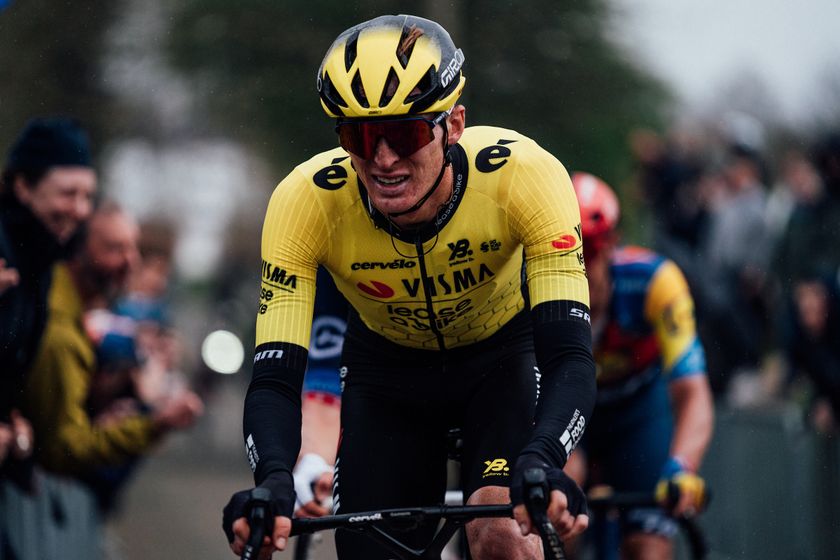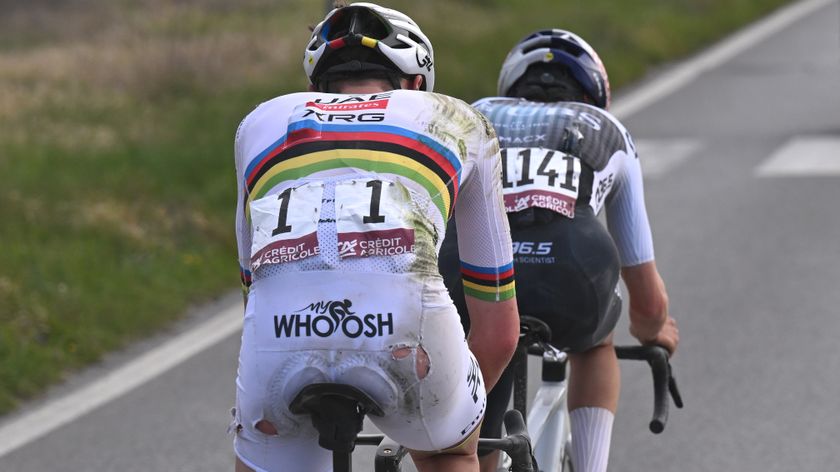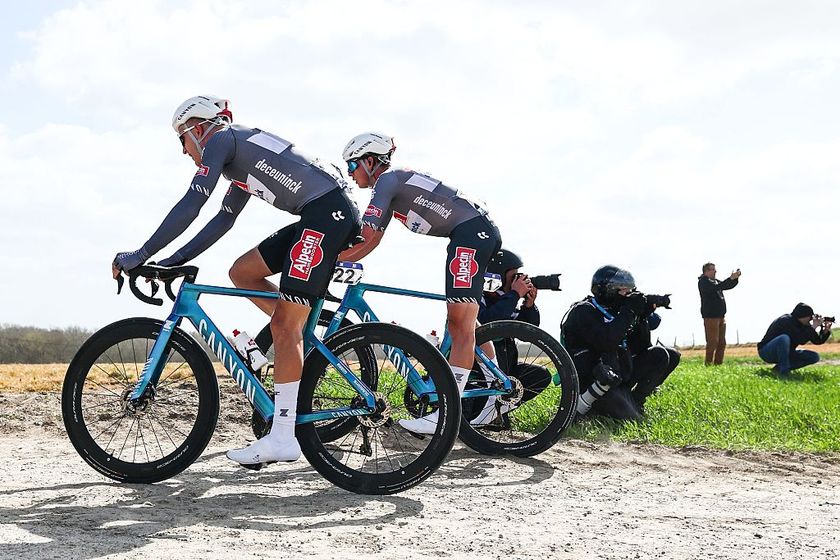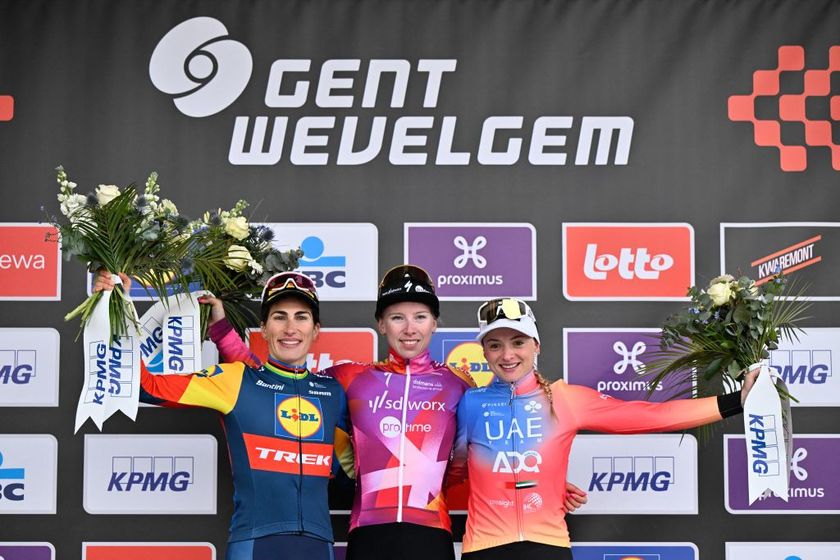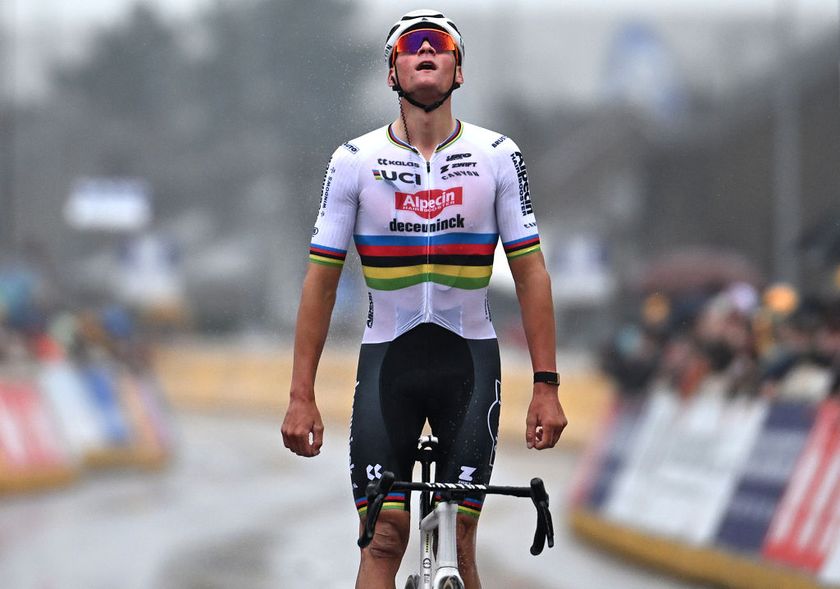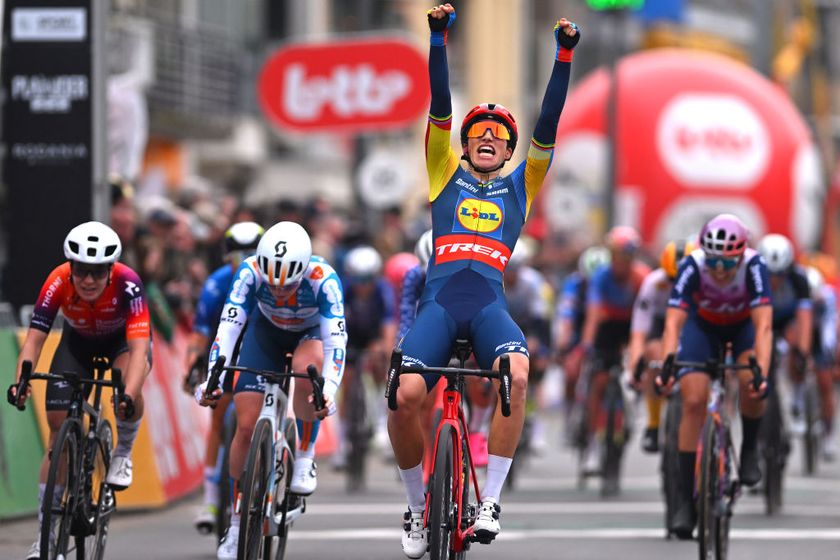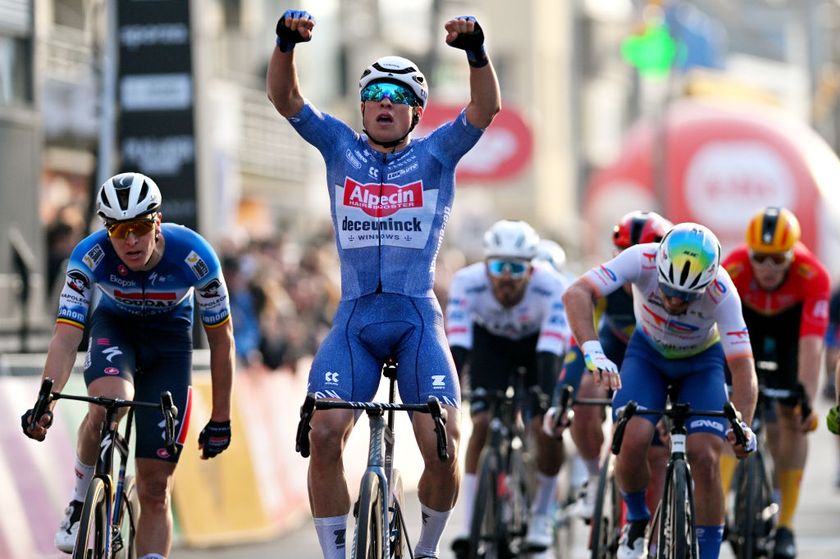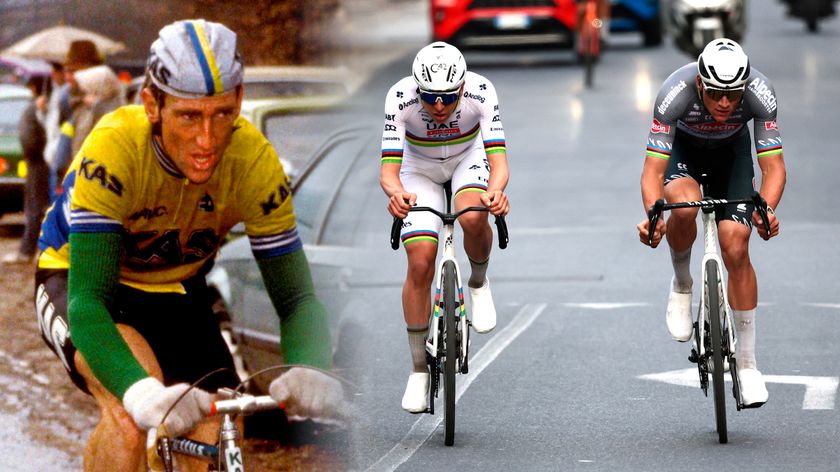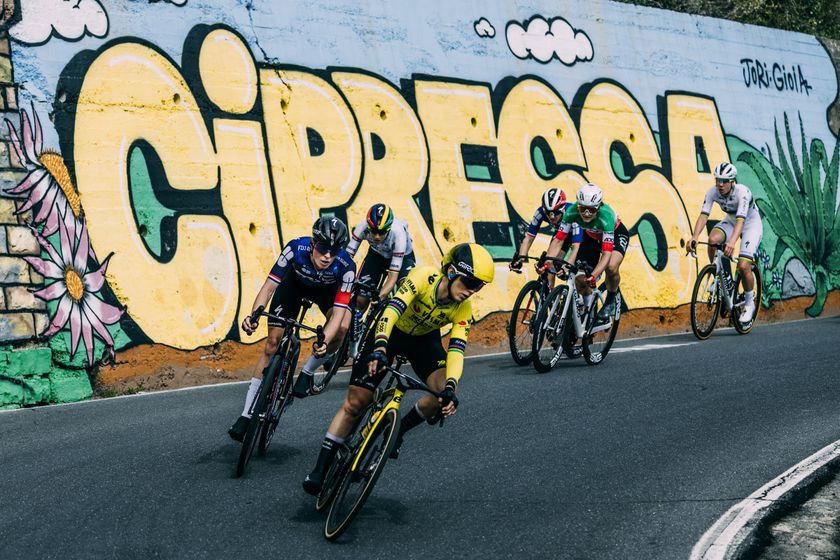8 conclusions from the Tour of Flanders
Sean Kelly shares his thoughts on a memorable edition of De Ronde





The 2017 Tour of Flanders seemingly had it all. Early hostilities, a stunning long-range solo, a moment of pure drama that will be hard to equal all season, tactical intrigue, joy, heartbreak, and a list of what-if's almost as long as the parcours itself. Cyclingnews has enlisted the help of nine-time Monument winner Sean Kelly to dissect one of the most memorable editions of De Ronde in recent memory.
Gilbert completes his renaissance
When Philippe Gilbert announced his departure from BMC Racing towards the end of the 2016 season many believed that the Belgian's best years were behind him. Those who argued such a notion certainly had a case; two years had passed since the 2012 World Champion had succeeded in a Monument, with only one victory in the second half of 2016. He was, by BMC's estimations, expendable and they were willing to see him pitch up at a rival Classics powerhouse and lose his expensive contract in the process.
Just three months into the move to Quick-Step Floors and it's already looking like the transfer of the season. Gilbert not only looks like a revitalized figure but he's arguably the closest he's been to the tantalizing form he displayed during the dizzy heights of 2011, when almost anything seemed possible. His ride in Flanders was arguably more impressive than the way he brushed aside the Schlecks in Liege-Bastogne-Liege or sat up before the line in Fleche Wallonne to blow kisses to the crowd.
On Sunday Gilbert was as decisive as he was powerful. While others hesitated he was brave enough to take the race head on. Of course it helps when you have riders of Tom Boonen's and Matteo Trentin's calibre to decimate the field before your winning attack but, for the majority of Gilbert's lone 55km venture, the race hung in the balance.
Would the chase have caught him had they not fallen? We'll never know, but that's the beauty and the heartbreak of the Classics all in one. All that we know for certain is that Gilbert triumphed in one of the most memorable editions of Flanders we've seen in years. (DB)
Sean Kelly says: Gilbert's ride was extraordinary. To go from that distance out and to have such a powerful group chasing and still hold them off, was just incredible. Circumstances did help him a little bit but you can't take anything from his performance. It was monstrous. He left BMC but the change of team has given him a new motivation and he's been aggressive since the start of the year. At Paris-Nice he was attacking in the horrible weather with 40-50km to go and he's used that race as preparation for the Classics. Can he win all five Monuments? I think time is running out for him but maybe Paris-Roubaix is an easier one for him when compared to Milan-San Remo.
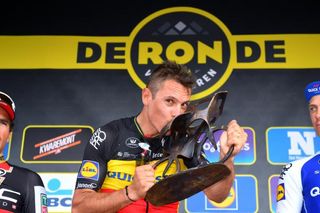
Things could have been so different without that crash
As Peter Sagan said on stage before the start of the Tour of Flanders, it's hard to predict the future. It's equally hard to predict what might have happened had something else occurred, but we can only try. At the time of the crash, which took out Peter Sagan, Greg Van Avermaet and Oliver Naesen, the trio of chasers were just under a minute behind Philippe Gilbert. The gap didn't appear to be closing, but the group looked strong, and Gilbert was beginning to show signs of struggling.
Get The Leadout Newsletter
The latest race content, interviews, features, reviews and expert buying guides, direct to your inbox!
Van Avermaet was able to remount fairly quickly, but he certainly lost time and, when a new chase formed, it was a much weaker line-up, with Dylan van Baarle and Niki Terpstra alongside the Belgian. Terpstra was not there to help, with Gilbert up the road, and, while enjoying a decent ride, Van Baarle did not have the firepower of Sagan or even Naesen. Despite this, Van Avermaet and his companions brought the gap down to 29 seconds. Although we have to take account of Gilbert's celebrations, it could have been a whole lot closer without the time and power that was lost in the crash. (SO)
Sean Kelly says: What I saw, and it was hard, was that Sagan had been riding for a while and was going full gas on the Kwaremont. He was on the limit and was too close to the barriers. His bars or pedal seemed to hook around the publicity hoarding but as a rider, when you're riding so hard you'll look for any advantage possible, and in this case he wanted the smoothest part of the road. The crash was certainly a turning point in the race, though. Gilbert was holding an advantage but when the crash happened the momentum really swung in favour of the QuickStep rider. He had to still contend with the headwind after the final climb but the crash was for the others did help him.
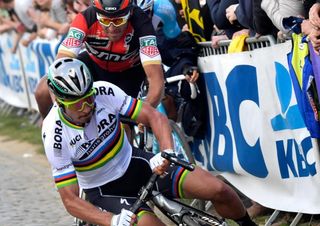
Sagan, without luck or a team
Peter Sagan's defence of his Tour of Flanders title went about as far from the plan as possible as he finished over three minutes down following a dramatic conclusion to his race. Sagan said afterwards that destiny had not wanted him to win, and there was certainly plenty of bad luck for the world champion throughout the race, but it was not just that which was lacking.
When the break went on the Muur, Sagan had been caught behind several crashes, leaving him stuck with no way of getting around. His teammate Maciej Bodnar did make the cut, and Sagan later tried to jump the gap but was brought back by Trek-Segafredo. Bora-Hansgrohe tried to mount a chase, but it did little to pick away at the advantage of the leaders. Bodnar's time in the front group, a potential helper for Sagan in the latter stages, was brought to an end after he had to take evasive action to avoid the Sep Vanmarcke and Luke Rowe crash.
While Sagan and a handful of other contenders were still languishing behind, Philippe Gilbert was able to slip away unchallenged on the Kwaremont. The rest of the break did eventually come back, and things began to turn in his favour when Tom Boonen suffered mechanical problems, and he attacked on the Taaienberg. Just when it seemed that it was all coming together for the world champion, misfortune struck again.
There was not just one moment that lost Sagan an opportunity at winning a second Tour of Flanders, but many small factors. Misfortune played a big part but when push came to shove Sagan also lacked the support. (SO)
Sean Kelly says: Again it was a real surprise to see Sagan lose so much ground on the Muur when Quick-Step attacked. You can't say now, 'well if Sagan didn't crash then Gilbert wouldn't have won'. We shouldn't be talking that way. Gilbert's ride, to go from so far out, was incredible and it worked out.
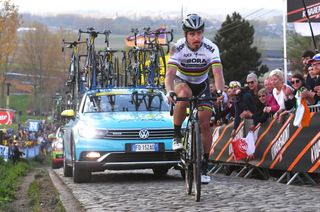
Van Avermaet's wait continues
It would be mightily harsh to judge Greg Van Avermaet's spring campaign as sub-par but the bare fact is that the long wait for a Monument continues. The question reverberating around the 31-year-old's head this morning as he lies awake, staring at the ceiling, will surely be 'what more do I have to do?'
In the lead-up to Flanders Van Avermaet had an accomplished arsenal in his locker. He had the form, the team, the confidence, the tactical nous and the gold fleece of Classics riding - the measure of Peter Sagan.
However, the only way to analyse Van Avermaet's Tour of Flanders result is to take it in isolation and to put aside the wins in Gent-Wevelgem, E3 Harelbeke and Omloop, because on the day it mattered most BMC were found wanting and were too often on the back foot during critical parts of the race. While QuickStep Floors were enacting, BMC were constantly reacting and, eventually, after walking a tightrope to keep his dream alive, Van Avermaet inevitably slipped. Even being better than Peter Sagan couldn't save him.
In his post-race press conference Van Avermaet pointed to Sagan's line choice on the Kwaremont and the subsequent crash but that detracted from the original question. We have 12 months to see if Van Avermaet can find the right answers. (DB)
Sean Kelly says: It was a surprise that both Sagan and Van Avermaet missed the split on the Muur. That's when all the damage was done. Being so far out, we thought it wouldn't have a bearing on the race but they paid the price. We'll be debating the effects of the crash until next year's Tour of Flanders. There were lots of falls for guys like Vanmarcke and then Sagan and Van Avermaet. When you look at the final they were close to catching Gilbert but we'll never know if they would have caught him.
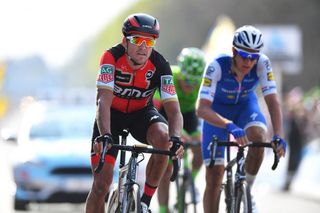
The Muur played its part in the end
When the new-look route for the Tour of Flanders was released last year, many were happy to see the revival of the Muur-Kappelmuur. However, even among those who were glad to see it back, there were questions about whether it would even play a factor in the race as it came with almost 100 kilometres and 10 more climbs still to run. Most riders dismissed it as a crucial point of the course.
Others, such as Quick-Step Floors, Katusha and Team Sky all had it down in their race plans as a somewhere to watch out for. They were right, and when Tom Boonen lit the touch paper, all three teams had riders present, along with a smattering of others. That move would go on to set up one of the most dramatic races and victories in recent times. Worries about the subsequent long stretch without any climbs to speak of proved unfounded as viewers were glued to their screens while the gap between the two groups continued to grow.
Prior to the race, the new route perhaps looked like a folly of nostalgia that would do little to change how things went down. In the end, the Muur justified its place and potentially cemented its inclusion for the foreseeable future. (SO)
Sean Kelly says: I like the route a lot and it's a very selective parcours. Putting the Muur back in was a success and it's always been a climb that’s made a massive impact on the race. We weren't expecting it to be so important yesterday but it turned the race on its head. Is it a better route that the previous one? I don't know but having the Muur back is great. It's key for Flanders and we could see yesterday that it played a big part in the outcome.
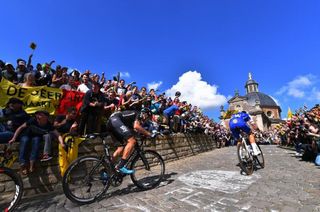
Vanmarcke stalls
Illness, crashes, bad luck, and now a smashed finger - this is shaping up to be Sep Vanmarcke's worst Classics campaign since his final year with Garmin in 2012. It's a consistency that will leave both rider and the management he returned to work under scratching their heads. The move back to Slipstream was supposed to elevate the happy-go-lucky Belgian to the next level – transforming him from strong, plucky player into fearsome contender. Instead, this Spring has seen the Classics rider take a step back as other riders have shown their credentials. At 28, Vanmarcke has plenty more opportunities but with every passing year, every near miss, one wonders if the stars will ever align for a rider who has the potential but has still not delivered on the biggest stage. (DB)
Sean Kelly says: Vanmarcke has been knocking on the door for a number of years. He was so unlucky yesterday in Flanders with his crash but you have to remember that he was in the move that went away on the Muur. When you have a fall like that though, it’s totally game over in race as hard as Flanders. I still think he can come back and one day win a Classic. He still has time.
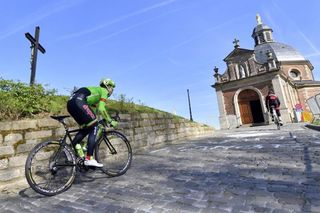
Team Sky's Classics campaign receives a blow
Team Sky has been hovering around the fringes at Tour of Flanders for the past five years but the Monument has proved an elusive beast for them. Last year, Luke Rowe picked up the baton from Geraint Thomas and scored the team their best finish of fifth.
Like several teams in the bunch, Team Sky knew that they would have to take the race to the favourites if they wanted to deliver. Rowe and Stannard went into the race as the team's leaders but Stannard hardly featured at all. In fact, it was Gianni Moscon that joined Rowe in the first group and who would go on to finish as their top rider in 15th.
Rowe was the last rider to make it into the breakaway on the Muur but he looked comfortable until he was taken down by a stricken Sep Vanmarcke. He was able to finish but he had suffered some serious abrasions to his arm and leg in the crash and it remains to be seen how he holds up for Paris-Roubaix on Sunday. We will have to see how Stannard fairs over his favoured terrain but Team Sky may have to look to Moscon for a result this weekend. (SO)
Sean Kelly says: I don't think Sky had a bad ride. They had Luke Rowe there and he couldn't do a lot when Vanmarcke fell in front of him. Until that moment Rowe had raced well and he had a teammate with him in that key group of around 15 riders.
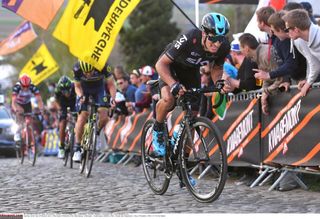
Lotto Soudal in limbo
When your only significant play in the Tour of Flanders involves your sprinter attacking into a headwind after the race-defining breaks have sailed away, serious questions need to be asked. Belgium's second team, Lotto Soudal, have been a huge let down in the cobbled races, with a fourth place in Kuurne-Brussel-Kuurne their best result. In Flanders they missed the move on the Muur and showed little ability to fight back even when the chase became somewhat organised. Tony Gallopin could be seen holding on for dear life on the last set of climbs, while Andre Greipel tried and failed to revive a campaign that has fallen flat. Roubaix offers a get out of jail but the reality is that the riders at the core of the Classics unit are down on form and confidence. (DB)
Sean Kelly says: They were a team that disappointed. They had no one in the split on the Muur and that was such a bad move to miss out on. They really needed someone like Gallopin up there. They had to start riding as a result and they weren't able to close it down quickly enough. You see guys like Sagan and Van Avermaet were able to get across later in the race but Lotto had no-one.
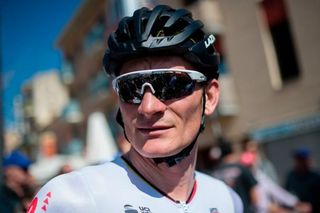
Daniel Benson was the Editor in Chief at Cyclingnews.com between 2008 and 2022. Based in the UK, he joined the Cyclingnews team in 2008 as the site's first UK-based Managing Editor. In that time, he reported on over a dozen editions of the Tour de France, several World Championships, the Tour Down Under, Spring Classics, and the London 2012 Olympic Games. With the help of the excellent editorial team, he ran the coverage on Cyclingnews and has interviewed leading figures in the sport including UCI Presidents and Tour de France winners.
